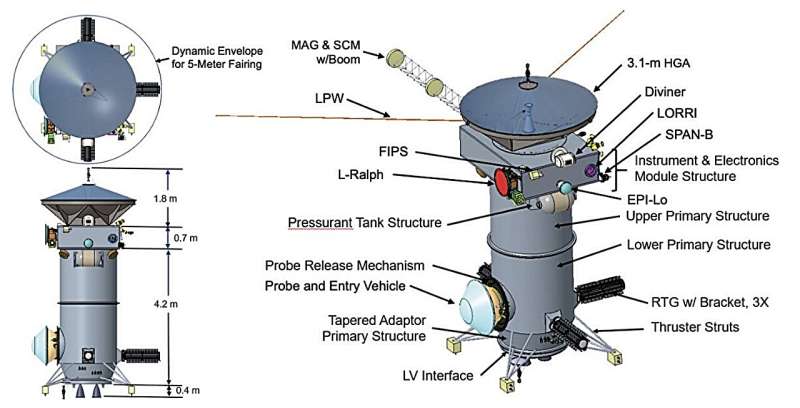Proposed Uranus orbiter mission. Credit: NASA Decadal Survey
Despite being extraordinarily difficult to detect for the first time, gravitational waves can be found using plenty of different techniques. The now-famous first detection at LIGO in 2015 was just one of the various ways scientists had been looking.
A new paper, appearing on the preprint server arXiv, from researchers from Europe and the US proposes how scientists might be able to detect some more by tracking the exact position of the upcoming Uranus Orbiter and Probe (UOP).
Initially suggested by NASA's Planetary Science and Astrobiology Decadal Survey, UOP will be the first mission to Uranus since Voyager visited the system in 1986. When it finally arrives in 2044, after a 2031 launch date, it will be almost 60 years since humanity last had an up-close look at the Uranian system.
But 13 years in transit sure is a long time. Part of that time will be spent getting a gravitational boost from Jupiter, but most will be spent coasting between planetary bodies. And that much time spent in between planets is what the paper's authors want to utilize to do non-Uranian science.
Gravitational waves can disrupt the fabric of space-time, causing discernible distortions, especially over long distances. If the instruments in question are sensitive enough, the massive distance between UOP and the Earth would be a viable way to detect them.
This isn't the first time using the distance between a spacecraft and Earth has been considered for detecting gravitational waves. Pioneer 11, Cassini, and a triangulation of Galileo, Ulysses, and Mars Orbiter all had entertained suggestions of being utilized for gravitational wave detection while on their journey to their final destinations. However, the equipment they were designed with was not sensitive enough to pick up the minute fluctuations required for an actual detection.
UOP will have the added advantages of decades of improved equipment, especially communications and timing electronics, which are critical to any gravitational wave detection. It also benefits that we've already officially detected a gravitational wave, so we know at least what to look for.
The underlying mechanism is simple enough—consistently track the exact established position of UOP during its 13-year cruise to Uranus and cross-reference any anomalies in its position against what could be expected from known causes. These include the gravitational pull of some of the planets, or even asteroids, and solar radiation pressure on the spacecraft itself.
As the authors note, some or even all of these could impact the spacecraft's exact position; for the calculations to work effectively to find gravitational waves, better accounting for what, if any, impact they have must be completed.
But there is another potentially scientifically interesting cause of slight positional drift for the UOP: ultra-light dark matter. In theory, UOP could be used to test or even directly detect a form of dark matter known as ultra-light dark matter if it happens to exist in the solar system.
Theorists have numerous models showing how it would work if it did exist. UOP could also use the same sort of exact positional calculation to contribute to that scientific research.
Best of all, UOP can do all this with literally no change to its primary functional mission—exploring the Uranian system. All that would have to be changed about the mission would be to update Earth with consistent positional data about once every 10 seconds for the duration of the 13-year trip to UOP's final destination.
Suppose there's a chance that those more frequent check-ins with home could help detect gravitational waves or potentially dark matter. In that case, it seems well worth the consideration of the UOP mission planners—but it remains to be seen whether it will be included or not. The paper's authors have made a persuasive argument about why it should be.
More information: Lorenz Zwick et al, Bridging the micro-Hz gravitational wave gap via Doppler tracking with the Uranus Orbiter and Probe Mission: Massive black hole binaries, early universe signals and ultra-light dark matter, arXiv (2024). DOI: 10.48550/arxiv.2406.02306
Journal information: arXiv
Provided by Universe Today
























